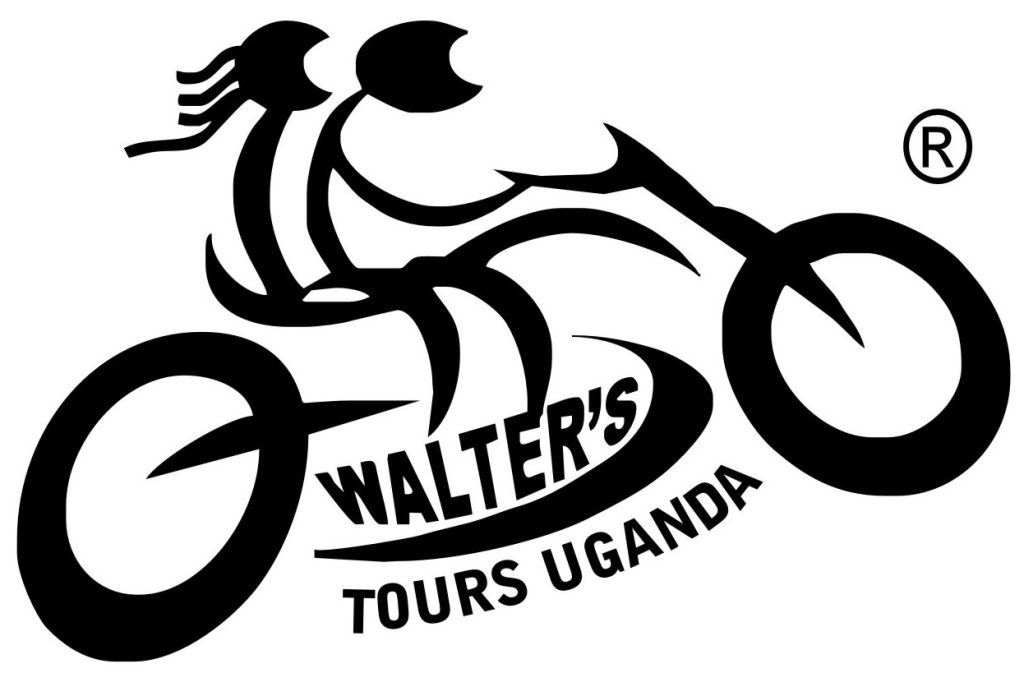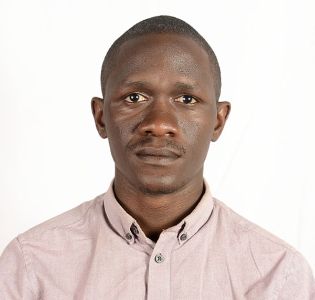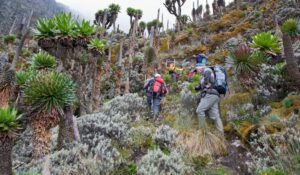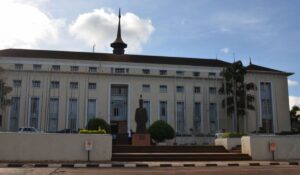One of our unforgettable but also popular must-do activities, Walter’s Boda Boda city tours of Kampala sometimes known as Kampala boda boda city tours gives you a different, new look and feel while traveling around Uganda’s Capital City, Kampala. An activity that can be done 6-7 hours before you catch your next flight on the same day. The activity has got several reviews on trip advisor, run in documentaries with world-renowned global news outlets like the CGTN, 2 BBC Africa, and CNN Business to local media such as the Uganda Broadcasting Co-operation (UBC) daily monitor, several travel bloggers, and vloggers. Other things are the slums and Beverly Hills of Kampala plus the feel of being on a bike with safe and knowledgeable experts.
1. Visiting the Gadaffi Mosque
Why our trip should start at the Gadaffi Mosque, is one; while at its highest peak the minaret, a point you reach after climbing over 250 staircases gives you a 360o orientation view of the capital city at both stopovers, in the midway, and at the end of the minaret. From there, you’re capable of keeping your city’s imagination on what places you will be capable of visiting. Gadaffi Mosque is the biggest mosque in Kampala, which can accommodate almost 20,000 Moslem believers on popular prayer days such as the EID El fitr and EID Aduha and other prayer days, the congregation seat in its main seating area, the gallery and the terrace which is receiving a new makeover. Visitors whether believers or non-believers are granted permission to tour, and capture interesting beautiful sceneries of its amazing architectural designs and its surrounding environment. This beautiful mosque has the country’s largest favic chandeliers held by strong chains, and beautiful carpet designs shipped in the country wholly un trimmed, hence one of the largest carpets in the country with little to few joineries.
The mosque blueprints were first thought of by Uganda’s Powerful and hardworking president, the last king of Scotland, Field Marshal, President Amin Dada and later its completion to the new state-of-the-art mosque in Africa was funded by Libya’s greatest president Colonel Muammar Al Gaddafi as a gift to Uganda Muslim community. It was named after him after completion but later renamed Uganda National Mosque after his death and loss of power in Africa.
2. Kabaka’s Palace and The Buganda Parliament
As the most organized kingdom out of the 57 tribes to monarchies in Uganda, The Baganda and Buganda are proud of having brought civilization to all of Uganda. While on our city tour of Kampala, you can’t miss these iconic and amazing designs of both the palace that is opposite to the Buganda parliament separated by a stretch with amazing totems that represent the different clans in which the Baganda people categorically fall into or clustered. Kabaka’s Palace once home to Buganda’s Kings sits on Mengo Hill Road, in the Lubiri Area enclosed in one of the longest walls in the country and with the only circular road that surrounds it (Ring Road).
It’s also called the haunted mansion, because so many were killed on the grounds, in the popular IDI Amin’s torture chambers, the palace is accessible, and its activities but with guided tours of the prison chambers.
3. Kabaka’s Lake
“Akayanja ka Kabaka” the popular Kiganda name meaning Kabaka’s Lake is the Largest man-made Lake in Uganda and the only Africa-dug dug-out lake with conventional tools such as hand hoes, spades, etc. Kabaka’s Lake was dug out in 1880 by the Buganda people on orders of the King, Kabaka Mwanga, both men and women of the monarchy that are clustered in the 52 clans of Buganda had the responsibility to dig out the Lake.
The Kabaka’s Lake covers almost an area of 2 square Kilometers with a depth of approximately 200 feet. The King’s Lake is among the top attractions places to visit while on our Bodaboda city tours of Kampala and it clearly defines the well-conserved sites of the Buganda Monarchy.
The Kabaka’s Lake has no inlet river tributaries but a small channel of an outlet supplied by underground springs, running water during the rainy seasons. Water levels have always been consistent throughout the year and it has shown any sign of drying out. The lake has a small island on which the Kabaka of Buganda sails, to perform some cultural rituals.
Kabaka’s Lake is one of the popular places for bird-watching paradise with numerous bird species such as the white egrets, Marabou stocks, etc. The Lake offers an interesting picture view backed up by the surrounding environment.
4. Uganda Museum
The Uganda Museum is located in Kampala, Uganda. It displays and exhibits ethnological, natural-historical, and traditional life collections of Uganda’s cultural heritage. It was founded in 1908 after Governor George Wilson called for “all articles of interest” on Uganda to be procured. Among the collections in the Uganda Museum are playable musical instruments, hunting equipment, weaponry, archaeology and entomology, and the first petroleum activities in the Albertine Region.
The museum started in a small Sikh temple at Fort Lugard on Old Kampala Hill. Between the 1920s and 1940s, archaeology and paleontological surveys and excavations were conducted by Church Hill, E. J. Wayland, Bishop J. Wilson, P. L. Shinnie, E. Lanning, and several others, who collected a significant number of artifacts to boost the museum. The museum at Fort Lugard became too small to hold the specimens, and the museum was moved to the Margaret Trowell School of Fine Art at Makerere University College in 1941. Later, funds were raised for a permanent home and the museum was moved to its current location on Kitante Hill in 1954. In 2008, the museum turned 100 years old.
5. Independent Monument
The Independence Monument is in many ways one of the most important pieces of Uganda’s heritage and independence. Located along Speke Road in Kampala, just opposite Standard Chartered Bank, the construction of the Independence Monument was funded by the British Colonial government in the days leading up to Uganda’s first independence celebrations on October 9, 1962. Depicting a woman unwrapping his child and raising it to touch the sky, the towering sculpture signifies a newborn country let free from the bondage of colonization.
A huge towering concrete sculpture stands behind the wall fence to the Sheraton Hotel, overlooking Speke Road and Nile Avenue. It stares down at the Grand Imperial Hotel to the right and Standard Chartered Bank to the left.
And here, on a concrete pedestal in front of a shrub of overgrown grass, the independence monument watches over Kampala and its people. It is an imposing work of art that shows a woman standing firmly on the ground with her legs slightly parted while hoisting a baby in the air.
The woman wrapping all over her body pensively looks as the little boy in her hands raises his hand in triumph. The child seemingly beckons the sky in triumphant jubilation while its mother seems to ponder the future.
6. Bahai Temple
The Bahá’í Faith was introduced to Uganda in 1951, making it one of the earliest Bahá’í communities in Eastern Africa. Since then, the Ugandan Bahá’ís have firmly established the Faith in their country, with members representing nearly every tribal and religious background and being located in over 2,800 localities throughout the country.
The first Bahá’í House of Worship on the African continent, completed in 1961, is situated in Kampala and has become a well-known landmark of the capital. Bahá’í Houses of Worship are spiritual gathering places open to all peoples. https://www.bahai.org/national-communities/uganda
7. Owino and Nakasero Markets
Owino Market
Also known as St. Balikuddembe Market. Owino Market is the largest open market in Uganda, occupying 7.04 hectares of land in Kampala, Uganda. It was established in 1971 when Kampala City Council relocated 320 vendors from Nakasero Market.
Initially, the Kampala City Council named it the Municipal Market, but the vendors later changed it to Owino Market after an elderly man whom they found in the area roasting maize and sweet potatoes. The initial structures were made of papyrus, then replaced by iron sheets and subsequently renovated with timber.
It’s estimated that there are over 50,000 vendors/traders in Owino Market, of whom approximately 70 percent are women. Thousands of customers visit this market on a daily basis, and the numbers tend to increase significantly a few days before public holidays and the festive seasons.
Owino Market is famously known for its secondhand clothes, but you can buy everything from herbs to home appliances, bedsheets, foodstuff, shoes, bags and so much more! It shouldn’t come as a surprise if you find yourself spending more time than you planned in Owino – the diversity of the fare is very attractive, and once you’re inside, it is quite hard to find your way out.
Nakasero Market
Nakasero Market started in 1895 when it was first established in Lubiri (Palace). In 1905, Nakasero Market was moved to Kagugube which was initially a temporary structure. In 1927, the market was established in the middle of Kampala, and it is the oldest in the capital. The market employs over 10,000 people from across Uganda and the wider region of East Africa. These include a diverse community of vendors, traders, service providers, and hawkers acting as a source of income to a rapidly growing urban population most of whom lack access to formal employment.
Hive of activity
Nakasero market was a joyous place to visit and buy a bounty of fresh produce. Notably, the customers were the middle-class Ugandans and the expatriate community, mainly whites who would come with their servants who would carry the wares.
8. Lubaga and Namirembe cathedrals
Rubaga Cathedral
The Towering House of God stands on top of one of the original seven hills that make up the city of Kampala. Visible from all angles, especially in downtown Kampala, St Mary’s and Sacred Heart Cathedral Rubaga, is indeed a city landmark hardly missed by visitors coming to the Pearl of Africa.
Saint Mary’s Cathedral Rubaga, commonly referred to as Rubaga Cathedral, is the parent cathedral of the Roman Catholic Archdiocese of Kampala, the oldest Roman Catholic diocese in Uganda. It is the home church of the Archbishop of Kampala.
https://klarchdiocese.org.ug/about-us/lubaga-cathedral/
Namirembe Cathedral
Saint Paul’s Cathedral Namirembe, commonly referred to as Namirembe Cathedral, is the oldest cathedral in Uganda. It serves as the provincial cathedral of the Church of Uganda and the diocesan cathedral for Namirembe Diocese, the first diocese to be founded in the Church of Uganda province, in 1890.
Namirembe Diocese is the oldest diocese in the province of the church of Uganda and it is centrally located. It started in 1897 as the Diocese of Uganda until it acquired the Name “ Namirembe Diocese ” in 1960. It covers the district of Wakiso, Kalangala, and parts of Kampala city. It comprises 1 cathedral deanery, 6 Arcdeaconaries, 62 parishes, and 342 local churches (congregations).
http://namirembediocese.ug/
9. Uganda Martyrs Minor Basilica, Namugongo
The Basilica of the Uganda Martyrs, Namugongo is a Roman Catholic minor basilica dedicated to the Ugandan Martyrs. https://www.ugandamartyrsshrine.org.ug/
When you get to our City tours of Kampala you can customize your interests and include such, amazing designs and magnificent architecture. we can get you to this incredible and biggest minor basilica in Uganda.
The Uganda Martyrs Shrine Namugongo is one of the largest Christian pilgrimage destinations in Africa dedicated to the 22 Martyrs and saints of Uganda who were martyred between 1885 and 1887 by the king of Buganda, Kabaka Mwanga II.
The Shrine is located in Kira Municipality, Wakiso District, in Central Uganda. approximately 15 kilometers (9.3 miles), by road, northeast of Kampala City.
10. Lake Victoria shores (Ggaba Landing site or Mulungo Landing site) to some people, this is usually one of the highlights.
On our City tours of Kampala, several activities are done during our tour, which involve getting off the motorbike and walking around to see firsthand what the sites offer, hunger always and tiredness are always depicted on your face, and looks and a need to re-energize. Stopping over at the Ggaba Landing site to grab a delicious popular fish meal, mainly tilapia of any size you feel you want to try out, boosts your glucose levels to an extent you couldn’t end the trip with us.
Gaba landing site is found on Lake Victoria, in Ggaba, Kampala Uganda. It is used as a center for fish trade in Uganda. The fish mostly caught in the waters near the site include Nile perch, Tilapia, Lungfish, and Catfish. Fishing is mostly done in the middle of the lake, a little distance from the site. It is tilapia that is fished near the shore. Fishing has changed at the site over the years, from using small canoes to using motorized boats. The mode of transportation of fish has also evolved. The fish are moved in containers with ice, unlike before when they were simply dropped inside a boat and then delivered.







7 Responses
Appreciate the recommendation. Let me try it out.
I used to be able to find good advice from your blog posts.
Article writing is also a excitement, if you be familiar with afterward you can write or else it is complicated
to write.
Wow, wonderful weblog layout! How long have you been running a blog for?
you make running a blog glance easy. The overall glance of your web site is great, as well as the content!
You can see similar: najlepszy sklep
and here sklep online
Wow, wonderful weblog format! How lengthy have you been blogging for?
you made blogging glance easy. The total look of your website is great,
as well as the content! You can see similar: sklep and here e-commerce
Just desire to say your article is as astonishing.
The clarity on your submit is just spectacular and i can think you’re an expert in this subject.
Fine together with your permission let me to grasp your
feed to stay updated with impending post. Thanks one million and please carry on the enjoyable work.
I would like to thank you for the efforts you’ve put in writing this website.
I am hoping to check out the same high-grade content by you later on as well.
In truth, your creative writing abilities has inspired me to get my own, personal website now
😉
Look into my blog web site